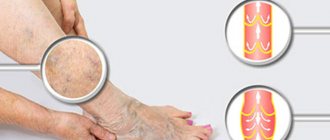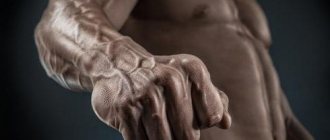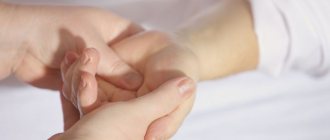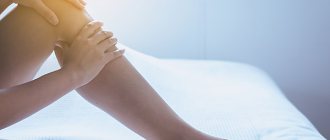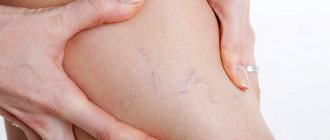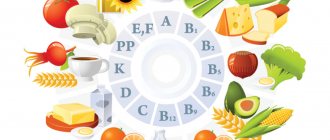Article publication date: 09/21/2018
Article updated date: 12/19/2019
Author: Yulia Dmitrieva (Sych) – practicing cardiologist
Protruding veins on the arms in most cases are only an aesthetic problem. As a rule, they are noticeable on the hands (especially on the middle, ring and index fingers), wrists and forearms, sometimes on the shoulders, and this phenomenon is observed more often in men than in women.
But the absence of physical discomfort does not always indicate the norm of such a symptom. If the veins in your arms protrude, this happens often, they are very visible, and even more so if they hurt, ache or pull, you need to consult a doctor to find out exactly the reasons for what is happening.
Why does this happen?
It is important to be able to distinguish in which case this symptom is a variant of the norm, a physiological condition, and in which it is pathological, requiring diagnosis and treatment.
This is what it looks like in the photo:
In ordinary healthy people
As a normal option, large swollen veins in the arms may appear in the following situations:
- A person regularly performs strength physical activity on his hands. In this case, the pressure on the vessels increases, expanding their lumen, and at the same time, the arm muscles become hard - they also help push the veins out.
- From the blow. The site of the bruise usually swells, the vessel becomes more noticeable and pronounced. If a person hits his hand right in the place where the vein passes, then it may swell, turn blue or purple, sometimes even turn black and a bruise will form around it.
- Thin, translucent skin (especially in girls, teenage boys and children), with a small layer of subcutaneous fat that could hide blood vessels. Normally, this problem should not cause cosmetic defects in a child.
- A hereditary feature is the superficial location of the veins. Most often, enlarged veins appear after too much physical exertion or when a person holds for a long time and then quickly lowers his hands. It occurs less frequently in boys than in girls.
- Hot weather, significant increase in air temperature. This factor sometimes provokes increased blood pumping in the extremities, due to which the vessels and capillaries increase in size, inflate and become convex (on the legs this manifests itself as varicose veins and swelling in the evenings).
- In older people, as a result of the aging of the body. With age, the elasticity of blood vessels begins to be lost, the walls of the veins are unable to maintain their shape, and the tortuous pattern on the hands becomes more noticeable.
- Pregnancy, postpartum period. In this condition, bulging veins in women is a physiological process associated with hormonal changes in the body.
- Blood collection, IV placement, anesthesia administration. In some people, the veins may swell after a blood donation procedure, or after a catheter is removed. In this case, the injection site often ache, itch, and there is redness and burning. This is an absolutely normal phenomenon that is associated with anatomy, there is no need to worry. But if there is also pain, you should consult a doctor, this may be a sign of post-injection phlebitis.
- When you lower your hands. A similar phenomenon is usually observed in people with problems with blood pressure, with increased blood density. When the arms are lowered, especially if they had been raised for a long time or were tense, the blood does not have time to circulate normally and the veins become more visible.
If the veins swell and then disappear, this may indicate a temporary circulatory disorder. In this situation, there is no point in trying to reduce them; they must hide on their own.
In athletes
In people who are actively involved in sports, veins appear much more often than in others. For example, in bodybuilders and bodybuilders, increased venousness and pulsation is due to the fact that during training the athlete’s arms bear a huge load - the vessels from the inside bulge from the muscles, which grow rapidly.
Another option is if the vessels of the upper or lower extremities swell immediately after training. This happens because physical activity increased blood flow and expanded the lumen of the vessels, which then come to the surface.
Due to illness
Pathological reasons for swollen veins in the arms are less common than physiological ones, but they should not be ignored. It is important to exclude in time a possible disease that will cause not only aesthetic inconvenience, but also possible serious complications in the future.
Most often, diseases that provoke such a symptom are:
- Varicose veins. It occurs when the walls of blood vessels weaken, causing congestion to clog them, causing them to swell and bulge under the skin.
- Thrombosis. With this disease, blockages (one or more) appear in the deep veins, which form a blood clot. The pathology is quite difficult to identify in the early stages, while the superficial vessels have not yet emerged; it is practically not accompanied by symptoms. From time to time a person may feel heaviness in the limbs and pain when palpated.
- Thrombophlebitis. This is an inflammatory process of the walls of superficial blood vessels. They become dark blue, in advanced cases they turn black and are very painful.
- Postphlebitic syndrome. A pathology characterized by a complication of deep vessel thrombosis.
All these diseases require timely treatment. If neglected, they threaten serious damage to the arteries, atrophy of part of the bloodstream and paralysis of the limbs.
How to treat varicose veins on the arms and palms?
Varicose veins on the hands are an unpleasant disease that worsens the appearance of the hands. Both men and women suffer from it.
But women are more often upset about it, since the disease spoils the appearance of their hands.
Having noticed bulging veins in themselves, patients wonder what they are and whether varicose veins occur on the arms.
It happens, but it is less common than varicose veins on the legs. The reason is that the load on the legs is higher than on the arms.
Symptoms
If you are wondering whether there may be varicose veins in your arms and suspect you have the disease, pay attention to the signs of the disease :
- On the hands . On the back of the hands, patients have bulging dark blue veins. Some veins are lumpy along their entire length up to the elbow. The appearance of the veins is embossed and ugly.
- on the palms , around which blueness is visible, and the appearance of the skin worsens.
- Varicose veins on the fingers are characterized by an increase in the size of the veins between the fingers. The swelling of the veins is also noticeable on the fingers themselves.
- Varicose veins on the hands with bumps are an advanced form of the disease in which the nodes on the veins become visible to the naked eye.
Stagnation of blood in the veins causes pain and discomfort. The upper limbs begin to respond to weather changes. There is numbness and cramps after sleep.
Patients complain of deterioration in hand motor skills: difficulties arise in performing work that requires finger dexterity. It becomes difficult for the sick person to hold things in his hands.
Causes
Provoking factors for varicose veins on the hands are:
- Disruption of the venous valves.
- Hard work with your hands.
- Extensive physical activity (sports training).
- Long-term use of OK (oral contraception).
- Hormonal imbalance during menopause.
- Genetic factors (predisposition if someone has been sick in the family).
- Overheating.
- Smoking and alcohol abuse.
- Obesity and metabolic disorders.
Treatment
Varicose veins on the hands are not dangerous to health . Surgeons rarely prescribe surgery. Pharmaceuticals, laser and ultrasound treatments are more often prescribed.
During the treatment of varicose veins on the hands, you should use fixing bandages or tight clothing and gloves. Do not overuse physical labor, so as not to cause swelling.
Treatment of varicose veins on the arm should not be postponed until later, so as not to trigger the disease and avoid inflammation and thrombosis.
Effective treatment for varicose veins on the hands includes:
- Compliance with medical recommendations (external and internal medications).
- Moderate physical activity.
- Cold and hot shower.
- Gymnastics for better blood circulation.
- A low-fat diet without preservatives and blood thickening products.
- Maintaining temperature conditions.
- Quitting alcohol and tobacco.
It is better to treat varicose veins of the hands in a comprehensive manner : warming up the hands improves the condition of the blood vessels, and ointments and gels help achieve a good cosmetic effect.
What to do if you have varicose veins?!
Read more >> |
Venotonic drugs are prescribed by a doctor.
Sometimes sclerotherapy is prescribed - a non-surgical procedure for treating vascular pathology. This is a fairly young technique.
The administration of the drug is painless and brings quick tangible results .
Pills
To improve vascular tone, increase blood circulation and reduce vascular fragility, tablets are used for varicose veins of the hands:
- Venarus, Aescusan, Phlebodia, Troxevasin, Venoturon.
- Blood thinners: Venolife, Lyoton, Trental, Warfarin.
- Heparin helps eliminate blood clots and reduce the likelihood of them forming.
- Painkillers: Diclofenac, Ketorol, Indomethacin.
Homeopathic remedies and vitamin complexes are taken along with the tablets (they should contain vitamins C and E). Microelements for maintaining health – silicon and zinc.
Creams and ointments
Ointments and creams for varicose veins help in the fight against the disease. They are used in complex therapy - tablets are combined with external treatment.
Application of ointments is simple - they spread well on the skin . One of the most inexpensive ointments is heparin. It helps improve blood circulation in the extremities, relieves swelling and has an analgesic effect.
- Gepatrombin and Lyoton penetrate into the deep layers of the skin and relieve pain, inflammation, and resolve blood clots.
- Troxerutin reduces the fragility of capillaries, relieves heaviness in the hands, improves the condition of blood vessels, compacting their walls. The gel is rubbed into the hands or compresses are made.
- Cream-wax “Zdorov” based on bee products is beginning to be used at the stage of varicose veins in the treatment of varicose veins of the legs. You can apply cream to your hands when the first symptoms appear. It contains natural ingredients: beeswax, horse chestnut extract, propolis, olive oil. It has anti-edematous and analgesic properties.
Similar drugs also help in the fight against the disease: Antistax, Varicobooster, Troxevasin, Menovasin, Vishnevsky ointment, ichthyol ointment, Horsepower gel, Sophia cream, Siberian Health balm, gel 911, turpentine ointment.
Traditional treatment
Traditional medicine knows several ways to combat varicose veins on the hands.
These include compresses with badger fat, treatment with leeches, rubbing with horse chestnut or Kalanchoe tincture, and baths with pine oil.
To relieve pain, drink decoctions of medicinal herbs: calendula, nettle, chamomile.
Along with traditional treatment, folk remedies are used : compresses from fern, tomato, willow branches, cabbage, honey. Rub with medical alcohol and apple cider vinegar.
- It is recommended to wear compression garments during the day and apply a warming bandage at night.
- Treatment of varicose veins of the hands at home should be agreed with a doctor.
Ointment recipe
Do-it-yourself ointment for varicose veins is made as follows:
- Take a tablespoon of rendered lard and mix in equal proportions with Vishnevsky ointment, honey, aloe and onion juice.
- Bring to a half-boil in a water bath.
- Immediately remove the homemade ointment from the heat and cool to 37 degrees.
- Warm ointment is applied under a compress and worn throughout the day.
You can use your own homemade ointment for varicose veins on your hands every day, and you need to store it in a closed jar in a cool place.
Source: https://provarikoz.com/vidy/na-rukax
Associated symptoms
In the case of pathological provoking factors, pronounced veins usually cause not only aesthetic, but also physical discomfort.
This mainly manifests itself:
- heaviness and pain in the hands;
- swelling of the hands.
One of the common symptoms is a constant desire to fix the arms above the level of the head (in this position, the outflow of stagnant blood improves).
In difficult cases, when vein pathology is caused by serious circulatory disorders, as well as thrombophlebitis, the following is observed:
- slight increase in body temperature;
- hyperemia of the skin of the hands;
- lump, lump, lump, swelling or ball at the site of the lesion;
- swelling, blueness;
- change in skin color;
- muscle weakness;
- the appearance of ulcers on the skin.
Symptoms
The initial stage is practically asymptomatic or with minor visual changes. That is why many do not pay attention to them.
The primary signs of varicose veins of the hands include:
- swelling and some increase in venous beds;
- tortuosity of veins;
- the appearance of a clear venous pattern;
- formation of small nodules;
- the ability to feel the veins with your fingers.
In general, pathology negatively affects the entire body, so as it develops, other parts of the body may also be affected.
- severe expansion of the veins, their swelling (on the hands they become clearly visible and tortuous);
- pain and a feeling of heaviness (symptoms become more pronounced over time);
- burning in the hands;
- swelling;
- performing monotonous work for long periods of time may be difficult;
- fast fatiguability;
- an unpleasant feeling of numbness and tingling in the hands;
- presence of venous nodes;
- convulsions;
- inflammatory skin diseases, dryness.
The main symptom of the disease is the manifestation of dilation, an increase in the size of the veins. The color changes from blue to bright red or blue.
Blueness appears next to the blood vessels, fingers and hands swell.
In the first stages, varicose veins do not express themselves. The disease is confused with overexertion.
Knowing for sure whether there can be varicose veins on the hands, the next equally important question is the characteristic clinical picture of the pathology. As a rule, the first signs of varicose veins go unnoticed, and therefore the disease often develops to moderate and severe degrees.
Symptoms of varicose veins on the hands:
- swelling of tortuous large veins in the arms;
- when you raise your hand up, the size of the veins will decrease;
- burning and pain syndrome of the hands;
- feeling of heaviness in the hands;
- noticeable swelling;
- difficulty performing the same action with one hand;
- increased fatigue;
- numbness in the hands.
You need to understand that varicose veins have an extremely negative impact on the functioning of the cardiovascular system and general well-being, therefore, over time, the clinical picture may be supplemented by symptoms of impaired heart function.
The thinner a person is, the more varicose veins will be visible. But there are cases when swollen veins are not a consequence of varicose veins, but rather the absence of fatty tissue under the skin.
Varicose veins of the hands are noticeable visually and are accompanied by pain, numbness of the hands and forearms. Particularly disturbing is the aching pain in the hands when the weather changes. Every day it becomes more and more difficult for patients to carry heavy objects and hold them in their hands for a long time. Patients pay attention to the following symptoms:
- the veins swell, become large, and a venous pattern clearly appears on the shoulder and chest;
- when you raise your hands up, the veins decrease in size;
- the brushes swell, bake and become heavy;
- when clenching a fist, the cyanosis in the vein area increases;
- Constant burning pain in the area of dilating veins disturbs sleep at night, puts you in a stressful and depressive state, and leads to headaches in the area of the heart muscle.
Treatment tactics
Treatment of any pathology depends on the cause that provoked it. Therapeutic measures for pronounced veins can be medicinal and surgical.
The last option is resorted to in two cases: either if the disease progresses and there is a risk of a large blood clot, or if the patient simply wants to eliminate an aesthetic defect.
| Cause of Vein Swelling | Therapy |
| Thrombophlebitis | Antiplatelet agents and anticoagulants, anti-inflammatory drugs, warm compresses. |
| Hereditary predisposition | An aesthetic problem that is inherited can only be eliminated through surgery. |
| Increased physical activity | Moderate exercise or temporary refusal of it will make the veins less noticeable. |
| Varicose veins | Surgical intervention or conservative treatment. |
General recommendations
To enhance the effect of drug or surgical therapy, you need to help the body remove (hide) visible veins.
- Drink enough clean, non-carbonated water. This will improve the structure of the skin of your hands, it will become smoother and more elastic.
- Avoid coffee and alcohol. This will make the skin color uniform, without a “gray” tint.
- Use hand creams. This can be either a simple moisturizer or a special anti-varicose cream. The latter will improve the tone of blood vessels, and, if the problem has not gone far, will hide them.
Hand exercises
There is a whole list of exercises (pictured below) that will help eliminate large veins.
Here are the most effective:
- Clasp your hands into fists, lower and raise them “all the way”, bending your hands – 10 times.
- Alternately extend your fingers to the back, then together.
- Gather the fingers of the right and left hands into a bun, lower them together downwards, bending the hand, return to the starting position - 10 times.
- Work your thumbs: pull them back and forth and to the sides.
- Clenching your hands into fists, twist them, bending your wrist.
- Forcefully bend and straighten your fingers into fists – 10 times.
- Place your palms together in front of your chest, bend your arms at the elbow joints, raise your elbows up, lowering your hands to your navel.
- Walk along any surface with your fingers, imitating playing the piano.
- Straighten your arms, point them in different directions, swing them in a circle - forward and backward.
- In the same position, bend your elbows and make circular movements of your limbs, first to the right, then to the left.
What tests need to be taken?
If the patient has other dangerous signs indicating varicose veins, he should first consult a phlebologist. The doctor will examine the patient (palpation) and, if necessary, prescribe additional research methods.
Laboratory tests are considered mandatory. The following methods are used to diagnose vascular diseases:
- Blood test (general).
- Urine examination.
- Biochemical blood test (to determine cholesterol and other parameters).
- Blood test for clotting.
These tests will help evaluate the properties of the blood and diagnose possible vascular diseases.
Necessary examinations
You can diagnose possible diseases that provoked swelling of the veins in the arms and pain in them using additional diagnostic methods. These include:
- Segmental Dopplerography.
- Magnetic resonance imaging of veins.
- Computed tomographic phlebography.
- Ultrasound diagnostics of vessels of the upper extremities.
Alternative Therapies
If the veins become very enlarged and protrude, but there are no blood clots or a threat to health, alternative medicine can come to the rescue. This is a whole set of folk recipes, treatment with leeches, acupuncture.
Important: before deciding on unconventional methods of treatment, you need to consult a doctor and make sure that the chosen method will not harm or aggravate the situation. Poor patient tests will be the first contraindication for the use of alternative medicine methods.
Reviews from doctors about alternative medicine are mixed, but all experts agree that they can only be used when there are no blood clots or visible varicose veins.
Folk recipes
We bring to your attention popular recipes for folk remedies that can help with swollen veins in the hands:
- Take a green tomato (according to the degree of ripeness), cut it into slices, place it on your hand in the place where the veins emerge and swell, and wrap it with an elastic bandage overnight. In the morning, remove everything and spread the skin with a high-fat cream.
- Mix crushed wormwood (3 tablespoons) with the same amount of curdled milk, smear the resulting medicine on your hand and wrap it in cling film. After 20 minutes, remove the compress and spread the skin with rich cream or sour cream. This will take up to a month.
- Apple cider vinegar and birch bud tincture are mixed 1:1, rub your hands with the resulting mixture twice a day.
- Chopped garlic and butter in equal proportions are mixed and applied to the hands in places where the veins are swollen. The compress needs to be insulated as much as possible (using cling film and a towel on top). You will have to smear visible veins for up to 5 months.
- Drink herbal tea: rose hips, blueberry leaves, rowan berries and St. John's wort are mixed in equal parts. Take half a glass twice a day, brewing a tablespoon of the resulting tea with boiling water.
Hirudotherapy
Treatment with leeches is practiced even with pronounced veins, when the hands swell from insufficient blood outflow.
The essence of hirudotherapy is that a specially grown medical leech is placed on a patient at a certain point on the body. During the bite, a substance, hirudin, enters the blood, which thins it and prevents blood clots.
Patients note an improvement in the appearance of their hands and overall well-being after the first session. After manipulation, the leech is placed in medical alcohol.
Acupuncture
Using this method, certain points of the human body are affected by introducing special thin needles into them. They activate biological processes in the body, thereby restoring normal blood flow and preventing congestion.
This method is not recommended for everyone, as it has a number of contraindications. Before deciding to go to an acupuncture session, you need to take all the tests and notify your doctor.
Drug therapy
Varicose veins of the hands are treated with tablets, drops (orally), creams and ointments (topically) with the addition of important components:
- horse chestnut extracts;
- lily of the valley extract, mistletoe;
- routine (vitamin P).
Among the drugs, treatment is carried out: Cyclo 3, Antistax gel, Venolife, Viatromb spray, Detralex tablets, Phlebodia 600, Renoven balm and other means.
You can prepare an ointment yourself: floured chestnuts are mixed with melted pork guts (1:1) and the areas with affected (protruding) veins are lubricated with light massage movements.
If there is no interior fat in the house, then you can make a lotion from crushed flowers and wormwood leaves mixed with yogurt or kefir. The pulp is spread on the affected veins and fixed with a bandage or linen cloth.
Treatment of varicose veins on the hands with hirudotherapy (leeches) is popular. It is appropriate and useful if the procedure is performed by an experienced specialist who knows all the intricacies of leech therapy.
Prevention
Preventive measures aimed at preventing the swelling of veins on the surface of the skin of the hands come down to reasonable exercise and a healthy lifestyle.
They include:
- charging;
- quitting smoking, alcohol and coffee;
- taking a contrast shower;
- balanced diet.
The condition in which the veins protrude on the arms is one of the most common problems, in most cases diagnosed in the fair sex. Enlarged veins that appear through the skin can also be found in men who engage in strenuous sports.
Physical exercise
What to do if a vein in your arm becomes inflamed will be determined by your doctor after a full diagnosis. In order to normalize blood circulation, it is recommended to perform therapeutic exercises.
It consists solely of stretching:
- stretch your arms forward, pull your palms up and then down;
- fingers gradually form a fist on each hand, then open them back in the same order;
- fold your hands as before prayer at chest level and in this position raise them up.
Causes
Most often, swollen veins in the arms appear as a result of exposure to provoking physiological factors. However, there are cases when dilated venous vessels may indicate serious vascular pathologies.
Physiological reasons include:
- Hereditary predisposition. This problem is mainly diagnosed in people whose relatives have protruding blood vessels on their hands.
- Lack of fatty tissue in the skin. If it is in small quantities, it can cause the veins to become noticeable.
- Age. As a person ages, blood vessels become less elastic and weakened. As a result, stagnation of blood fluid and dilation of veins occurs. In addition, aging leads to thinning of the skin, against which the blood vessels become more visible.
- Hot weather. Too high an air temperature can provoke vascular dilation and disrupt the functioning of venous valves. It is for this reason that blood vessels protrude strongly on the surface of the epidermis in the hot season.
- Hormonal imbalances. Often occurs during pregnancy or at the onset of menopause in women in adulthood.
- Intense physical activity. Protruding veins on the upper extremities are a fairly common occurrence in people involved in heavy work or sports. Such types of activities contribute to an increase in blood flow, increased hardness of muscle tissue, which can provoke an expansion of the venous lumen.
Possible complications
If left untreated, the disease can lead to the development of severe complications. The most common ones include:
- Thrombophlebitis. The cause of the disease is prolonged venous stasis, which provokes the formation of blood clots and subsequent blockage of the lumen of the vessel.
- Trophic ulcers. They are ulcerations of the skin caused by insufficient oxygen supply to the tissues, as well as exposure to toxins. Ulcers are very painful. It takes a long time to heal. It is possible that a secondary infection may occur, which will significantly worsen the current condition.
- Destruction of varicose veins. The resulting venous nodes can rupture as a result of physical exertion or accidental injury, which causes massive bleeding.
Conditions require immediate medical attention.
Diagnostics
Additional diagnostic studies are carried out when there is reasonable suspicion of the development of vascular pathologies in which the veins in the arms stand out.
First of all, the patient is prescribed an ultrasound examination, which makes it possible to visualize superficial and deep vessels, blood clots and other problems that cause blood flow disturbances.
Venography may also be done. Its essence lies in the introduction of a contrast agent into a vein and subsequent X-ray examination.
Diagnosis of varicose veins
Ultrasound examination allows you to determine the degree of vascular dilation.
When the first signs appear, the patient should immediately contact a specialist who, using an ultrasound examination, will determine the nature of the disease and the degree of vasodilatation. In addition, a number of tests and studies are prescribed that will help quickly determine the cause and period of the disease. A competent approach to the treatment of varicose veins will allow you to effectively carry out therapy and get rid of unwanted symptoms. After diagnosis, the patient is prescribed to wear special compression sleeves or gloves that stabilize blood circulation in the extremities. Treatment of varicose veins on the hands is carried out using:
- medications;
- sclerotherapy;
- laser exposure;
- operations;
- hirudotherapy;
- traditional medicine.
When to see a doctor
Swollen veins in the arms cause a lot of discomfort. As the problem progresses, if it is caused by various pathological factors, the condition worsens. The vessels begin to bulge strongly, the patient is concerned about increased pain and swelling of the limbs in the evening.
If the veins are visible, the following symptoms will be observed:
- heaviness and pain in the hands;
- numbness of fingers;
- frequent desire to throw the head back.
When a lesion appears against the background of thrombophlebitis or other vascular diseases, additional signs appear:
- redness of the epidermis;
- skin thickening;
- temperature increase;
- swelling.
If you identify one or more of the listed symptoms, you should immediately seek help from a specialist. This condition can cause heart disease .
Initial symptoms of varicose veins
As is commonly believed, with varicose veins, the vessels should swell and begin to swell. Many believe that with this pathology bruises and severe pain in the legs necessarily appear.
However, not all of these signs can be noticed at the initial stage of the lesion. Let's talk about the sensations that should make you wary.
- regular discomfort and fatigue in the legs,
- the calves of the legs itch and itch,
- a burning sensation and pain may appear on the foot, which become more active at night,
- heaviness and swelling of the legs become your constant companions,
- at night you feel seizures.
If a vein in the leg is swollen and bruises appear, you will not always be able to notice it. For example, the area behind the knee is difficult to reach. The same applies to the vessels in the anus. However, based on your feelings, you can suspect the presence of a problem.
Treatment is necessary to prevent the veins from being affected by a more serious stage of varicose veins.
Treatment
If the pathology is diagnosed in a timely manner, then in order to remove bulging veins, it will be enough to use drug therapy.
In this case, the following drugs may be prescribed:
- Non-steroidal anti-inflammatory drugs - Ketonal, Ibuprofen. Allows you to eliminate pain and stop the inflammatory process.
- Improving blood circulation - Vasoket, Actovegin, Trental. Minimize the likelihood of developing blood stagnation.
- Anticoagulants such as Aspirin. Helps thin the blood and reduce the risk of blood clots.
- Fibrinolytic enzymes – Fibrinolysin, Urokinase. Their action is aimed at thinning the blood.
- Antiplatelet – Dipyridamole.
- Local action - Dolgit, Troxevasin. Relieves pain syndrome.
Each drug has a different composition and mechanism of action. Therefore, only a doctor can prescribe medications based on the general condition of the patient.
ethnoscience
At an early stage of development of the inflammatory process affecting the veins in the arms, it is also possible to use folk remedies.
It is worth using one or more of the most effective recipes:
- Concentrated apple cider vinegar. Before use, it must be diluted with the same volume of tincture prepared from birch buds. This composition is used to lubricate hands in the morning and evening.
- Grate several heads of garlic, mix with butter in a 1:1 ratio. Apply the resulting mixture to a bandage and apply to the affected skin of your hands. Secure the bandage with adhesive tape. The course of treatment with this method lasts from three to five months.
- Mix crushed wormwood flowers and yogurt in equal quantities. The product is applied to the skin for about a third of an hour. Residues of the medicine are removed under running water. Next, you need to apply high-fat sour cream to your hands for a couple of minutes.
It is important to remember that, no matter how effective this or that method of therapy is, especially for unconventional methods, it can only be used after consultation with a specialist.
Exercises
Certain exercises can help get rid of protruding veins:
- straighten your fingers back, first one by one, then together;
- tilt your thumb forward and backward with a slight movement;
- spread your fingers out to the sides as much as possible,
- walk your fingers across the table.
Such exercises help improve blood flow and restore joint function.
Procedures
The following measures are helpful in treating bulging veins:
- Sclerotherapy. The impact on the affected area is carried out by introducing a special liquid that glues the vessel, which helps to completely stop blood circulation.
- Hirudotherapy - treatment with leeches. It will only take a few sessions to normalize blood flow and improve blood vessels.
- Ultrasound. Under the influence of waves, formed blood clots are destroyed.
- Laser therapy. It is one of the most painless and safe methods. The vessels are irradiated with a special laser and glued together.
Your doctor will tell you which method to choose.
Therapy
It is possible to determine how to remove veins in the arms only after a full diagnosis. Taking into account its results, the doctor prescribes medications, sclerotherapy, physiotherapeutic procedures, useful exercises, and surgery.
Medication
For minor manifestations of pathology, external agents are prescribed that help strengthen venous tone:
In case of severe manifestations, the use of tablets is added to such drugs. They help increase the strength of vessel walls, restore microcirculation and blood outflow. Effective tablets:
In the presence of thrombophlebitis, the use of anti-inflammatory drugs and antibiotics is additionally prescribed.
Surgical intervention
Surgical treatment methods are used for acute circulatory disorders associated with blockage of blood vessels. In such cases, the patient experiences swelling and redness of the skin, fever, and suppuration.
This method of treatment is used mainly for thrombophlebitis, the consequences of prolonged intravenous injections. Laser therapy is considered effective.
Treatment with folk remedies
Folk remedies are used only in combination with medications. Such therapy cannot be the main one due to lack of effectiveness. For internal and external use, it is recommended to use herbs with a venotonic effect:
Plants that help thin the blood:
- Golden mustache;
- willow bark and leaves;
- raspberry leaves;
- sweet clover;
- peony flowers.
Such remedies are effective in the initial stage of development of the pathological process and will help get rid of veins on the arms. Only they are effective in combination with medications.
Prevention
To prevent veins from bloating, you need to follow some simple recommendations:
- control body weight;
- do not wear tight clothing;
- avoid lifting heavy objects;
- minimize physical activity;
- eat a balanced diet, eat more fresh fruits and vegetables;
- lead a healthy lifestyle.
Due to the fact that the veins in the arms can protrude for various reasons, you should not self-medicate.
At the first signs of deviations, it is better to consult a specialist. He will help identify the provoking factor that caused the problem and select the most optimal treatment option.
Those who paid attention to the hands of singer Madonna, film actress Angelina Jolie and TV presenter Yulia Vysotskaya must have noticed how visible the veins in their hands are! Is it really not possible to remove them somehow? After all, celebrities have a lot of opportunities to look perfect!
Is it necessary to do this? We’ll talk about this on the women’s website “Beautiful and Successful”.
Prevention and prognosis
Why the veins in the arms swell can only be determined by a doctor after a full examination. To prevent such pathologies, the following recommendations should be followed:
- avoid overheating the body;
- adjust the daily diet (limit the consumption of foods that retain fluid in the body);
- drink 1.5-2 liters of water per day;
- eat a lot of vegetables and fruits every day;
- to refuse from bad habits;
- avoid frequent physical activity;
- do swimming, yoga.
The pathology generally has a favorable prognosis if you consult a doctor at the first signs of its development. This is influenced by the reason for the appearance of veins on the arms, the age and characteristics of the body of each patient. A specialist will tell you how to get rid of veins on your arms. It is not recommended to self-medicate, especially with folk remedies.
The material was prepared specifically for the website venaprof.ru, edited by clinical pharmacologist K.V. Nedelko.
Use navigation on the current page
Unsightly bulging veins on the arms bother many women, although they are not a serious health problem. Sometimes bulging veins can be caused by vascular diseases and require careful investigation of the development of the disease. Visible arm veins are most often normal, without pathological changes. They expand due to heavy physical activity. Their function is to ensure blood flow from the arms to the heart.
Large bulging veins on the forearms and hands appear most often due to relaxation of skin tone and thinning of the skin. The reason for the development of loss of elasticity and firmness of the skin is most often age, although swelling of the veins is also possible due to active physical activity. Varicose veins on the arms usually do not cause pain, but remain a serious aesthetic problem for some representatives of the fair sex (varicose veins on the arms before and after treatment photos).
Why are veins visible on my arms?
As many women age, the veins in their arms are clearly visible, and this is due to physiological changes in the body. But why do veins sometimes appear on the arms of young women? What is this connected with?
Let's look at the main reasons why some women have very visible veins on their arms.
Physiological features
The appearance of noticeable blue veins on the hands may be associated with physiological characteristics of the body.
- As you know, with age, the skin becomes thinner and loses its elasticity. This is due to the fact that there are no sebaceous glands on the hands. Over the years, thinning of the subcutaneous adipose tissue is observed. That is, the fat layer in which the veins were previously hidden becomes thinner, and the veins protrude outward. If veins become visible on your hands with age and do not hurt, you should not be afraid of this - this is a natural process of skin aging.
- Also, the appearance of bulging veins may depend on the hereditary characteristics of the skin structure. Thus, veins can be noticeable on the arms of thin people with thin skin. They shine through the thin top layer and become visible on the surface of the brush. This is often due to genetic features of the structure of the skin: if your mother has noticeable veins on her arms, then you will most likely have this feature.
- Veins are also very visible on the hands of “wiry” people. If this is not so scary for men, then women often suffer from the fact that they have visible veins on their arms, and they don’t know what to do about it.
- Veins may appear on the skin in hot weather. From the heat, blood vessels begin to dilate, blood circulates faster, and veins begin to swell. In cold weather, veins may not appear as clearly on the skin.
Main stages of varicose veins
It is important to remember that even a small swollen section of a vein somewhere should alert you. The stage of the disease can be determined by how much the vessel swells. In total, there are several stages in the development of varicose veins.
- Problems with veins can appear almost anywhere - on the forehead, palms and even in the anus. At the first stage of the disease, you may notice a vascular network in the form of stars, different in size.
- The second stage is characterized by the fact that the blood vessels begin to dilate and protrude from the thickness of the epithelium. If the veins on your temples are swollen or protruding on your hands, you will definitely notice it. This is explained by the fact that the skin in these areas is especially delicate and sensitive. During pregnancy, the vessels of the legs are more susceptible to pathology.
- If a vessel swells at the third stage of the disease, the patient will immediately experience severe swelling of the changed area. Either just one leg or both limbs at once may swell. During pregnancy at this stage, you may notice that the veins on the chest have protruded too much. This is also an alarming symptom.
- The fourth stage of varicose veins can no longer go unnoticed. In addition, this condition poses a serious threat to the patient’s health. A striking manifestation of this stage is the formation of eczema on the forehead, fingers and other areas. Dermatitis in the facial area can occur if the veins in the neck are damaged.
- The fifth stage of venous varicose veins is a swollen network of vessels with swelling protruding above it. If nothing is done, trophic ulcers begin to form on the human body. It is especially unpleasant if the problem occurs on the wrist or elbow.
- At the last, sixth stage of the disease, deep veins are affected. As a rule, the clinical picture ends with venous breakthrough and profuse hemorrhages. Of course, it is better not to let the pathology reach such a state, because in some cases everything can end tragically.
How to remove bulging veins on the arms?
The best way to remove veins on the arms that are very visible is to prevent them from appearing. Therefore, starting from the age of 30, it is important not only to systematically care for your hands, not forgetting about their hydration and nutrition, but also to perform simple preventive measures.
These exercises should help remove small veins that have already appeared on the arms without resorting to surgery.
Set of exercises
So, the set of exercises is aimed primarily at preventing deep folds from appearing on the arms, which can tighten the vein. To do this, you need to very often perform any exercises (do finger exercises) that will stretch the space between the fingers. The great thing is that you can do these exercises anywhere - on public transport, in queues, just walking down the street, etc.
- Swing all phalanges of your fingers. Something like how we do “Magpie-Crow” for little children.
- Bend and swing all the creases in your arms and hands.
- Spread your fingers out to the sides.
- Walk your fingers along the surface of the table.
- It is also necessary to perform exercises with raised arms daily to improve blood circulation.
That is, try to do all the exercises that will force your fingers and hands to move to prevent the formation of deep folds and folds.
Sometimes, when performing these exercises, pain may occur, but then the pain recedes into the background and the condition of the hands improves - they become smooth, and the veins on the hands are not so visible.
Hand massage
Don't forget about hand massage. Massaging your hands will help remove muscle creases and remove folds on your hands - you will make room for the formation of subcutaneous tissue. Work with your hands a little every day.
Why does pain occur?
The causes of dysfunction of the venous system in the arms do not necessarily depend on specific vessels.
An adaptive reaction to frequent carrying of heavy weights and playing sports is increased blood flow to the muscles of the arms. Accordingly, an equally accelerated outflow is required. But the veins “work” much more slowly than the arteries, so some of the blood stagnates, causing the picture of vessels that “crawl out” out.
This traditional way of carrying weights does not cause early damage to the veins in the arms
Excessive tension of untrained muscles can be accompanied by rupture of veins. If a vein in the arm bursts, a burning sensation first appears, and then the bruise gradually increases (subcutaneous hematoma). In a person with good immunity and blood clotting, resorption will occur after a few days.
It has been noted that in trained people, tension is distributed along the entire vein, while in people who are not adapted to physical work, local “bumps” appear on the veins of the arms and large hematomas due to pronounced deformation of the vessels.
Another reason for an increase in the superficial venous pattern is loss of weight, fluid, asthenicity, and thinning of fatty tissue on the skin of the hands. This picture is typical for young women who want to lose weight. In their desire to achieve perfection, they forget about the advisability of maintaining the internal homeostasis of the body and end up with premature aging of the skin.
Surgical methods for treating bulging veins in the arms
Often the veins on women's arms are so visible that exercises and massages alone are not enough to improve their condition. Patients who seek help from specialists complain that their arms with bulging veins look old and unkempt, so they want to remove the bulging veins.
Experts today practice several methods to remove bulging veins on the arms. This can be done using several methods.
Laser treatment
The laser beam glues the walls of blood vessels, and blood stops moving through the veins. Naturally, the vein disappears and is not visible on the arm.
Sclerotherapy
The essence of this method is identical to the treatment of veins with a laser - to turn off the bulging vein from the blood circulation. To do this, special preparations in the form of foam or liquid are injected into the vein, which glue the walls of the vessels, and the vein fails.
By the way, we rarely perform sclerotherapy on our hands. Everything is connected with the peculiarities of this operation in the area of the hand. If you perform this operation incorrectly, you will only get a nagging pain throughout your entire arm, and will not remove the bulge.
Abroad, a special type of banding is performed to prevent thrombosis.
Miniphlebectomy
This is an operation to remove a bulging vein in the arms. Protruding veins are removed through special punctures with an instrument.
It is very important to remember that with any surgical intervention the veins become unsuitable for intravenous injections. They are simply removed from the blood supply.
ethnoscience
To reduce the manifestations of varicose veins in the hands, you can use traditional medicine recipes. Various decoctions and infusions prepared from medicinal plants thin the blood and prevent congestion in the veins. Compresses have a healing effect, warm baths improve blood flow, and rubbing relieves pain.
Traditional healers recommend cleaning varicose veins with lemon and garlic.
The recipe for making the product is simple. You need to grind 4 peeled heads of garlic and 4 peeled lemons in a meat grinder. Transfer the mixture into a three-liter glass jar, add warm water and let it brew for 3 days. The mixture should be stirred periodically. The tincture must be strained. Take 100 g before breakfast, lunch and dinner. The course of admission is 40 days.
Compresses
For varicose veins of the hands, you can make compresses with ichthyol ointment. Ointment is applied to a bandage folded in several layers, the bandage is folded again and again soaked in ichthyol. This needs to be done again. Then you should apply a compress to the sore area of the arm or to the affected vessel and secure it with an elastic bandage. The bandage stays on the arm for a long time - up to 4 days.
Another compress is vinegar. To prepare it, fold the bandage in several layers, moisten it with vinegar essence and place it on the area most affected by varicose veins. The bandage is fixed with an elastic bandage and lasts for half an hour. It is best to lie down during this time.
Salt compresses are becoming increasingly common. For varicose veins, they not only relieve pain and swelling, but also improve a person’s overall well-being. To prepare a salt dressing, make a 10% salt solution: dissolve 1 tsp in 100 g of water. seasonings The bandage should be applied to the sore arm, secured with an elastic bandage. The compress lasts for about 2 hours.
Green tomatoes will help with varicose veins of the hands. Vegetable slices are applied to diseased veins for 20-30 minutes.
Rubbing
Varicose veins on the hands are recommended to be treated with rubbing. A good remedy for this is vinegar and birch tincture, which is sold in pharmacies. You can rub your sore hands once a day, before going to bed.
A good rubbing remedy can be prepared from the medicinal plant Kalanchoe.
A 1 liter glass jar is filled halfway with Kalanchoe leaves and topped up with vodka to the neck. The product is infused for 1 week. You need to rub your sore hands once a day.
Baths
For varicose veins on the hands, relaxing baths are recommended. They should be prepared from medicinal herbs and other beneficial substances. You can use the following recipes:
- Dissolve 100 g of soda and 35 g of alum in 1 liter of hot water. Wait until the water cools to room temperature. Keep your hands in the bath for 10-15 minutes. The procedure is repeated 2-3 times a week.
- Pour 1 liter of boiling water over 100 g of marsh cucumber. Leave for half an hour, strain, add 10 ml of vegetable oil and a drop of essential oil. Keep your hands in the bath for a quarter of an hour.
Medical methods
Now let's touch on ways to eliminate bulging veins, which are practiced in modern medicine. Using them yourself is, of course, problematic. But it’s useful to at least briefly go over the main areas. In the future, you will be able to choose the best option for yourself.
- Massotherapy. Its purpose is to remove creases on the hands and elbows that interfere with the natural flow of blood. Therapeutic massage can only be performed correctly by a specialist - either a professional massage therapist or a physiotherapist. Gradually, the skin becomes smoother, and nothing interferes with the flow of blood.
- Therapy with leeches. This method is known as hirudotherapy. Do not think that treatment with leeches is some kind of charlatan way of pumping out money. In fact, it can be very effective, since leeches inject their own enzyme, which helps improve the functioning of blood vessels in general.
- Laser bonding. The most modern medical method is exposure to a low-intensity laser beam. The veins literally become stuck together so that blood can no longer flow through them. As a result, the blueness disappears, as do the bulges on the hands.
- Miniphlebectomy. This option is practiced only in extreme cases, since it can be painful and requires special doctor skills, and is expensive. Miniphlebectomy is the surgical removal of the largest veins. Afterwards, a short period of rehabilitation is required, which also does not add to the popularity of the method.
- Sclerotherapy. This is a chemical method of removing veins from their “working state”. The task is similar to that posed by laser gluing. Reagents or special foam are used only to clog the bloodstream.
Finally, there are many folk methods, but we will not consider them in detail. Taking tinctures or applying ointments not originally intended for such use is associated with numerous dangers and complications. If you are going to drink any questionable composition or drug, be sure to ask your doctor about its properties.
Enlarged veins are a common and not the worst phenomenon. In any case, if they appear on your hands. Most often, simple manipulations are enough to help make your hands beautiful again, get rid of unpleasant cyanosis and not develop additional diseases associated with the functioning of the circulatory system.
Preventive measures
The effect of therapy can be supported by lifestyle changes, periodic intake of prescribed medications, as well as traditional medicine. All kinds of rubbing, compresses, and baths for the limbs are used.
You can get rid of pain in your hands with an apple rub: finely chop 1 kg of apples, add a liter of boiling water to them, leave for 2 hours. After cooling, mix everything until smooth. Apply apple pulp as follows: once a day, rub a small amount of the mixture into the affected area.
Apple cider vinegar compresses are used for burning sensations in the veins. To do this, fold the bandage several times and moisten it in apple essence. This bandage is applied to the affected arm or leg for half an hour a day.
For varicose veins without signs of phlebitis in the compensation stage, you can make baths for the lower extremities. Take a small amount of crushed willow bark, dilute it in 500 ml of water, boil for 30 minutes. Such baths take 20-30 minutes. Upon completion of the procedure, you should put on compression garments and lie down to rest.
Other effective remedies for vein diseases include tinctures of chestnut fruits and acacia flowers. Young nuts, onions, garlic, etc. have healing properties.
Traditional methods of treatment should be treated with caution. It is better to consult your doctor before using this or that product.
